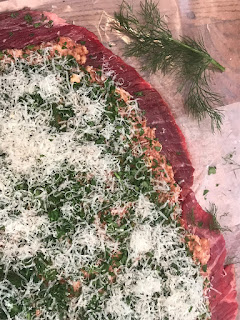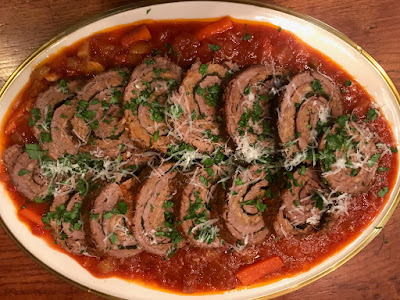In my younger days I lived in Boston - on Hancock Street, just a a few steps off 'Dot' Ave - and played the role of the impoverished student. But it wasn't bad enough to rate the term, really. I had my GI Bill, and a part time job, and rent in a condemned building is awfully cheap. With a little prioritizing, one could live pretty well. Volume could be the key consideration. As my similarly situated friends (there were several habitable apartments in Hancock House, as we called it) quickly learned, on a diet predominantly of Jell-O and popcorn, we need never stoop to drinking domestic. I hear even now the stately toast - 'Gentlemen, I give you - starvation!' Those were the days.
And when splurging was an option, there was spaghetti. At Purity Supreme, the grocery around the corner, a pound of it went for just 55 cents. The ingredients for a respectable sauce - even with meat - could be had for a few bucks more. There were other delicacies within our means. Like these super thin cuts of round steak - not so cheap by the pound, but sliced so thin that a little went a very long way. They were labled braciole - which I assumed was pronounced like broccoli with an Italian accent - and were terrific done up in a skillet for a breakfast of steak and eggs.
Then along comes a friend who not only knew how to pronounce braciole (brah-'zhol), but actually had a recipe, and showed us what it was all about. Stuffed with Italian sausage and braised with tomatoes, it was absolutely fantastic with spaghetti.
I have since learned that braciole is typically made with a stuffing of breadcrumbs, parsley, cheese and pine-nuts - but at best, that's only so-so with spaghetti.
Down South, odds are you won’t find the already thin sliced braciole cuts on the butcher’s shelf; so you have to butterfly it yourself.
And when splurging was an option, there was spaghetti. At Purity Supreme, the grocery around the corner, a pound of it went for just 55 cents. The ingredients for a respectable sauce - even with meat - could be had for a few bucks more. There were other delicacies within our means. Like these super thin cuts of round steak - not so cheap by the pound, but sliced so thin that a little went a very long way. They were labled braciole - which I assumed was pronounced like broccoli with an Italian accent - and were terrific done up in a skillet for a breakfast of steak and eggs.
Then along comes a friend who not only knew how to pronounce braciole (brah-'zhol), but actually had a recipe, and showed us what it was all about. Stuffed with Italian sausage and braised with tomatoes, it was absolutely fantastic with spaghetti.
I have since learned that braciole is typically made with a stuffing of breadcrumbs, parsley, cheese and pine-nuts - but at best, that's only so-so with spaghetti.
Down South, odds are you won’t find the already thin sliced braciole cuts on the butcher’s shelf; so you have to butterfly it yourself.
Which brings us to flank steak. It’s
not only a great cut of beef - its dimensions are made to order. It's also
fairly easy to butterfly.
FOR THE BRAISING SAUCE:
1 medium onion chopped;
5 carrots, julienned;
1 small fennel bulb, thin sliced in
2 inch lengths (save the fronds);
6 garlic cloves, minced;
1 24 oz can tomato puree;
1/2 C chicken broth;
1/2 C dry vermouth;
1/4 C olive oil;
Salt and pepper
FOR THE BRACIOLE:
1 flank steak, 1 1/2 pounds or so,
butterflied - pounded to about 1/4 inch thickness;
1 pound hot Italian sausage (removed from
casing if using actual sausages);
2 C freshly made, and not too fine bread crumbs (if using store-bought, make it 1 1/2 C Panko);
1/2 C parsley, finely chopped;
1/2 C selected fronds from fennel
bulb, finely chopped;
Parmesan cheese for sprinkling
TO MAKE IT:
1. PREHEAT OVEN TO 350 DEGREES
2. Butterfly the steak. You’ll need a
long, sharp knife. A boning or carving knife is ideal. Lay the steak on the cutting
board before you, with the grain (which is easily seen on a flank steak) running
up and down. Imagine the steak is a book, and you wish to open it at the
middle-most page - but the pages are glued together, so you will have operate. The
steak will probably be about an inch thick. You want to cut that thickness in
half. Hold the knife as flatly as possible and cut along the middle of the right
edge (or if you are left handed, the left edge) and saw a little, working your
way up and down the length of that edge.

 Continue, deepening and smoothing, until
you can peel back the top half of the
book, and keep peeling and cutting until it is in fact like an open book - but
do not go so far as to cut it in two. Then flatten it with the heel of your
hand, cover it with plastic wrap, and pound it with a meat mallet - front and
back - as uniformly as possible, until you have a general thickness of about a
quarter inch.
Continue, deepening and smoothing, until
you can peel back the top half of the
book, and keep peeling and cutting until it is in fact like an open book - but
do not go so far as to cut it in two. Then flatten it with the heel of your
hand, cover it with plastic wrap, and pound it with a meat mallet - front and
back - as uniformly as possible, until you have a general thickness of about a
quarter inch.
Now that you’ve read all this, it may
have occurred to you to JUST FIND A VIDEO DEMONSTRATION on line.
If by chance the steak comes apart on
you, no worries. It does not have to be all in one piece. You can make more
than one braciole. It will all be sliced into so many roundels anyway.
3. Blend sausage with bread crumbs
until spreadable, and mold sausage over the steak, covering each piece,
maintaining a margin of about an inch; cover it evenly with parsley and fennel fronds; sprinkle with Parmesan cheese.
4. Starting with a wide end - with
the grain, as you face it, running left and right, east and west - carefully,
tightly roll the steak, just as you would a jelly-roll. The grain should be
running with the length of the cylinder you are forming - that way, when the
roll is sliced into roundels, you will be cutting against the grain - which
makes for better eating.
Then, with 10 inch pieces of string,
at 2 1/2 - 3 inch intervals, tie the roll securely. Generously salt and pepper.
Cut the roll in half, for better maneuverability. Now you are ready to sear it.
5. In a Dutch oven, over medium high
heat, bring the oil to shimmering. Add meat rolls, and, turning with tongs,
brown thoroughly. Remove and drain.
6. Reduce heat to medium, add carrots,
onions and garlic; sauté, stirring
occasionally. When vegetables have wilted, add broth and wine, scraping the
bottom to loosen any tasty residue from the saute. Blend in the tomato puree, and
bring to bubbling.
7. Place steak rolls back in Dutch
oven, turning them in the sauce. Transfer the Dutch oven to the preheated oven and cook COVERED 1 hour, giving the meat another turn about half way through. Then, turn the rolls again, and cook UNCOVERED 30 minutes.
8. Remove the rolls, allow to cool, and slice into 3/8 - 1/2 inch roundels.
9. Serve atop pasta, covered in sauce and grated cheese.







No comments:
Post a Comment